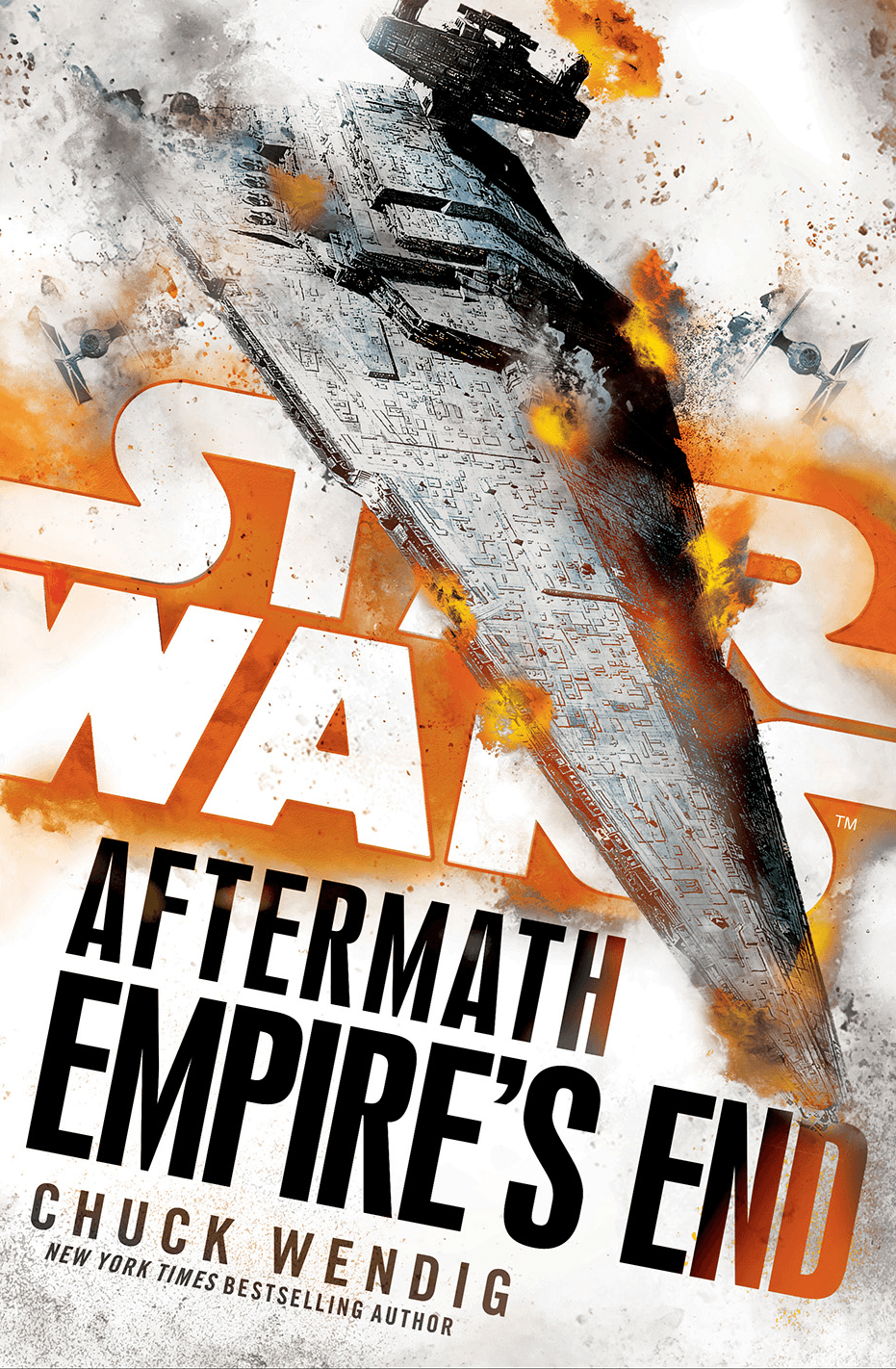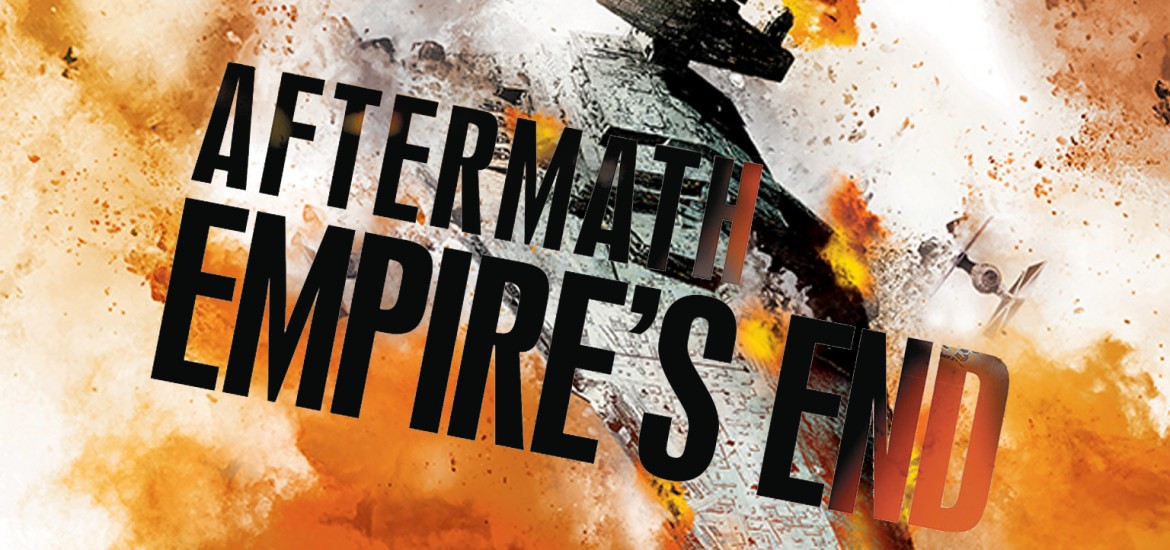Star Wars Beyond the Films‘ Nathan P. Butler is now posting short, non-spoiler reviews for many new releases. Spoiler-filled discussion will often follow in the weeks or months thereafter on the podcast. In the case of Empire’s End, discussion was recently released in episode 216 of the podcast.

Aftermath: Empire’s End by Chuck Wendig (hardcover, 2017)
The third book in the Aftermath trilogy has arrived, bringing with it a bit of wary hope. Those who follow Star Wars Beyond the Films here on SWR are likely already familiar with my thoughts on the first book in the trilogy, simply entitled Aftermath, released on Force Friday 2015. (If not, the discussion between me, Mark Hurliman, and Michael Morris can be found in episodes 189 and 190 of the podcast.) That book did not receive very high marks from me in that discussion, but the second book in the trilogy, Life Debt, fared quite a bit better in our discussion on the book in episode 202 of SWBTF and in my text-based review. I was cautiously optimistic that the third book in the trilogy would continue in the vein of the stronger, second book, rather than fall back to the lows of the first. So how did Empire’s End measure up?
Empire’s End
Empire’s End (not to be confused with the two-issue comic series of the same name from the Legends Continuity) picks up months after the end of Life Debt, as Norra Wexley’s crew work to hunt down Grand Admiral Rae Sloane, who has, unbeknownst them, essentially been deposed by Gallius Rax as the leader of the Empire. Sloane meanwhile has gone to Jakku with Brentin Wexley to stop Rax’s machinations.
What follows is a story set mostly on Jakku with political and espionage elements on Chandrila and new New Republic capital Nakadia, all centered around the idea that Rax has gathered the Imperial fleet at Jakku for a final confrontation, and the New Republic must engage them there in a battle that will determine the fate of the galaxy. That clash is the Battle of Jakku that has been hinted at (and briefly seen in Lost Stars) since before The Force Awakens hit theaters.
Along the way, pieces on the Aftermath Trilogy game board shift and develop to eventually reach final destinations far from where we met them back in Aftermath, some for the better, others not so much. I use the game metaphor purposely here, as this novel finally reveals the nature of the Contingency and Palpatine’s ultimate post-Empire plan being carried out by Rax, which is explained to Rax in a flashback interlude during a board game.
Of all of the books thus far with the possible exception of Bloodline, this is the one that finally sets the stage for the end of the Empire as we knew it and the eventual birth of the First Order. As such, it is a pivotal, necessary piece in the broader tapestry of Star Wars canon, pulling both Aftermath and Life Debt along with it.
That said, the book is the third part of a trilogy and fits that bill. Most of the novel is climax or build-up to the climax of events set in motion in the previous two books, rather than a tale that could stand particularly well on its own. We are invested in the characters by now, so seeing how things turn out for them here is interesting, but this novel in and of itself does not develop them as much as the previous two. (In fact, there is at least one major character from Life Debt who is given very short shrift in Empire’s End, so much so that the fate of the character is handled entirely “off-screen.”)
For those who did not enjoy the present-tense writing style of Aftermath or Life Debt, the same returns here, though more in the vein of Life Debt than Aftermath (i.e. not made of 1/3 sentence fragments). The interludes also return with mixed results. Sometimes they actually build upon characters met in interludes during the previous books and give us a glimpse at something else interesting in the galaxy. Other times, they seem superfluous and detract from the main story. Once, they even manage to bring Jar Jar Binks back, as Wending once noted long before publication (and many fans took as a joke, rather than truth).
The Verdict
For better or worse, Empire’s End continues the style of Aftermath and Life Debt. While it never quite reaches the strength of Life Debt, it remains a far cry better than the original Aftermath novel. With so many important events in this era taking place in a single book and such an impact from those events on the saga as a whole, Empire’s End has helped make the entire Aftermath Trilogy an essential (if sometimes groan-inducing) read for the Story Group’s new canon. By and large, it was enjoyable to read, as was Life Debt, and those might finally make up for the mess that was Aftermath.
Lastly, I should note that there is a standard hardback release of the novel, along with a “special edition” that is exclusive to Barnes and Noble, which includes a bound-in poster that features propaganda poster images of Norra on one side and Sloane on the other.
Recommended for: Those interested in important turning points in the Star Wars canonical saga, those who want to see where the characters from Aftermath and Life Debt finally end up, and those curious about the Battle of Jakku.
Not recommended for: Those who cannot stand third person limited writing in present tense or who simply cannot forgive some of Wendig’s social media tirades, politics, or sentence fragments.
The copy used for this review was a review copy provided by Del Rey. A Barnes and Noble Special Edition was also purchased at retail.
